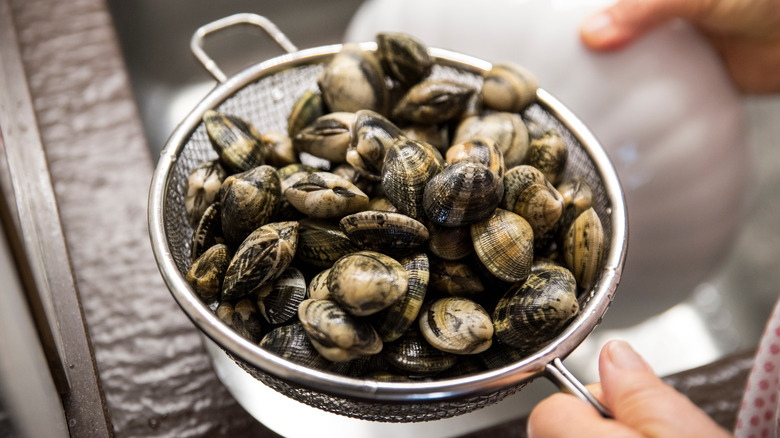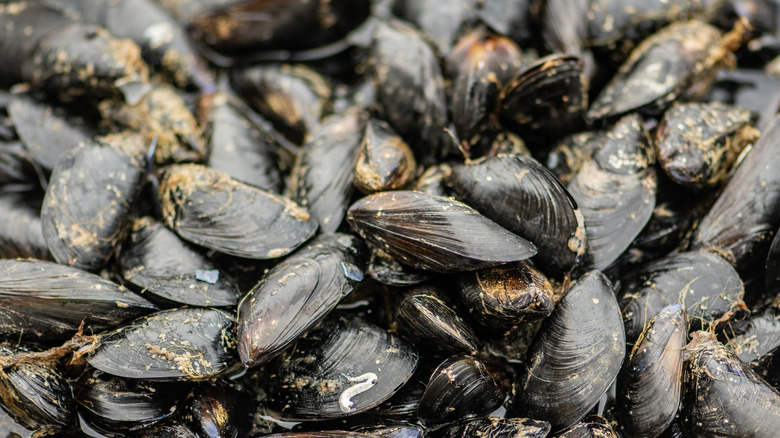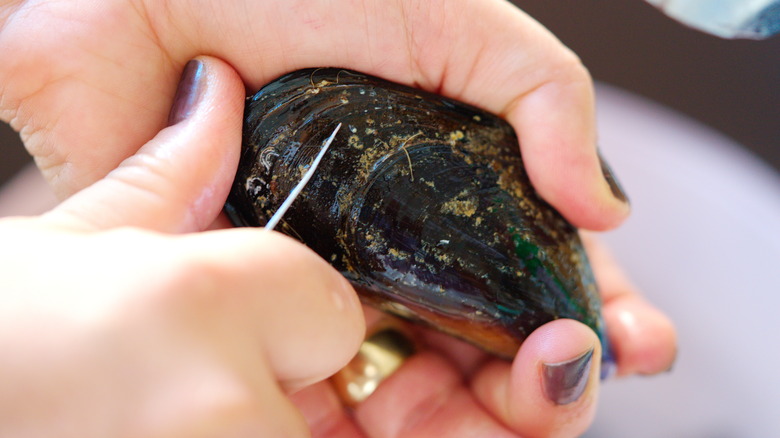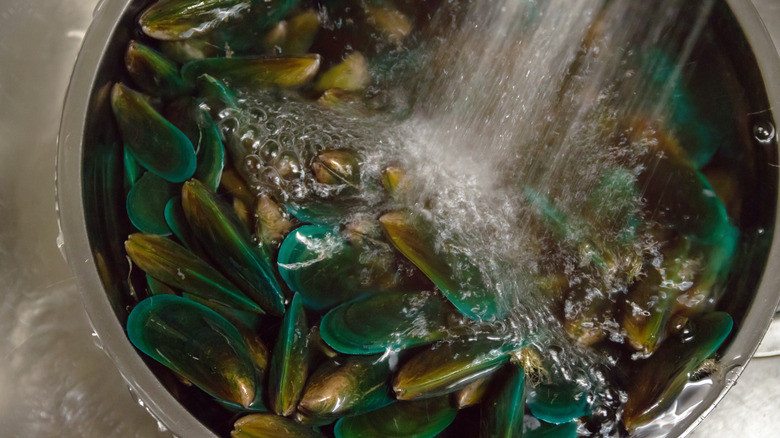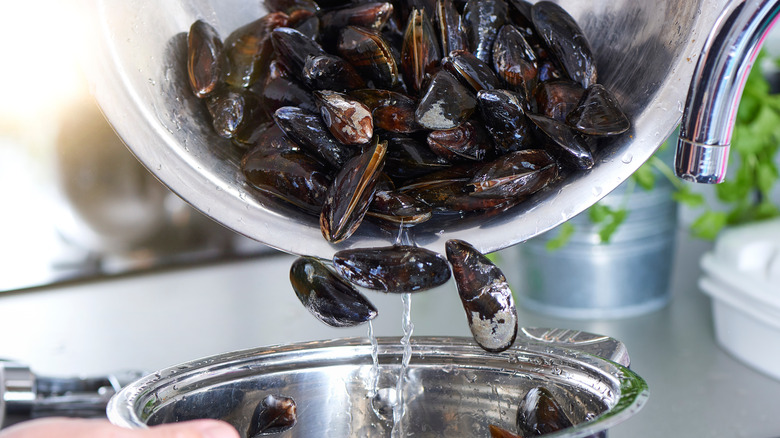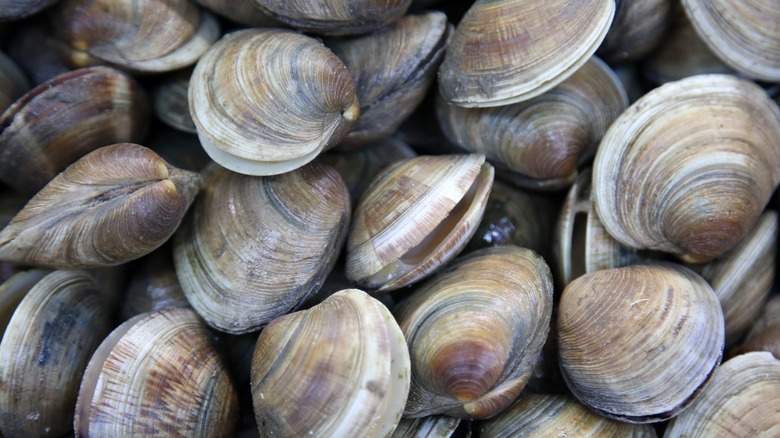How To Clean And Store Clams And Mussels
We may receive a commission on purchases made from links.
Clams and mussels are two popular bivalves that can be used in a variety of dishes that aren't very complicated to prepare. We're thinking about steamed mussels in a white wine sauce, raw clams on the half shell with tangy cocktail sauce, or creamy New England clam chowder. Still, these bivalves aren't one and the same because they have slightly different flavors and uses. But one thing they have in common is how they should be cleaned and stored. These fresh shellfish are alive, after all, so it's essential to keep them that way until it's time to cook.
We'll get into the specifics of properly cleaning and storing clams and mussels soon enough, but let's start with some basics. Before cooking, both should be scrubbed well and then soaked in salt water. Why? You don't want to end up with grit in your main dish — these delicacies are pulled deep from the sand. Storing them is just as crucial as cleaning because you don't want to kill the clams or mussels before it's time to cook, so let's dive into the details.
Look for signs of life
You never want to cook dead mollusks. They're dead for a reason, and we can guarantee it ain't good. Once they die, toxins build up in their tiny bodies, which they'll pass to you, no matter how much you cook 'em. Inspect your catch right after you buy the bunch and again before you cook them and toss anything dead. If you're throwing out more than a couple, be wary: "I'd worry about the toxicity of the overall batch," says Lynne Rosetto Kasper, host of American Public Media's "The Splendid Table."
How do you know if your bivalves are alive? Immediately get rid of anything with broken or damaged shells. Clams and mussels shells should be slightly open, and should shut quickly when you tap on them. If they're closed, don't shut or float in water, they're dead. Introduce them to the trash. Oyster shells, on the other hand, should be closed tightly. And, as with all fish and shellfish, your bivalves should have a fresh, oceany smell with no hint of fishiness or ammonia.
Scrub mussels and clams clean
Since most shellfish is commercially farmed, the product you're getting should be pretty clean, says Kasper. However, you'll want to give the outsides of the shells a good scrubbing to dislodge any remaining grit. Remove any beards by pinching and pulling.
Fun cleaning-related fact: Clams with darker shells (which are the result of growing in silt or mudflats) are generally easier to clean, says Steve Woodman, owner of Woodmans of Essex, a 100-year-old Massachusetts restaurant that specializes in fried clams. Lighter shells indicate that the clams grew in sand; they'll be harder to clean.
Soak them to remove all grit
Most hard-shell clams will be fairly grit-free. However, Peterson says, "Steamers and razor clams benefit enormously from an overnight soak in salt water." It has to do with their anatomy: Steamers (or soft-shell) and razor clams never close because of their siphon necks. "The sand isn't just in their shells — they actually ingest it, too," Branchina says.
To get rid of this pervasive grit, you'll have to purge them. Most experts recommend soaking the clams in salted water (in the refrigerator!) from an hour to overnight. Simply add salt to fresh water. "Make it taste like sea water," says Peterson. "You'll find a bunch of sand at the bottom of the bucket the following morning." Once rinsed, you're ready to steam, shuck and enjoy.
Give them room to breathe
Your bivalves are definitely alive, right? Keep them that way by storing them properly. Never store them in plastic: They'll suffocate. (That's why most come in a mesh bag.) Instead, place them in a colander set over a shallow dish, cover with a damp towel, and store in the coldest part of your fridge.
James Peterson, author of "Fish & Shellfish: The Cook's Indispensable Companion," recommends placing ice over the towel, and most experts recommend that you don't store them for more than two days. Don't ice your bivalves directly, as their hard shells belie a delicate flesh. "They die between 35 and 40 degrees," says Kasper. "The ideal temperature is around 33 degrees."
"If you really want to be a purist about it," says Nick Branchina, director of marketing for Browne Trading Co. in Portland, Maine, "store them packed in seaweed," which mimics their natural saltwater habitat.
How long do clams and mussels last?
After your clams and mussels are cleaned and stored properly, you don't have too long to use them because they should be eaten as fresh as possible. Typically, shellfish that are actually fresh at the time of purchase can be stored in the fridge for up to seven days. When it comes to clams specifically, they can last for a few days in the refrigerator. The answer varies for mussels, but they should be eaten within one to two days if stored in the fridge properly, as we explained earlier.
Either way, the sooner you eat them, the fresher they taste. They should smell like the ocean, so let your sense of smell guide you. You should also drain any water daily to keep them fresh. And if the clams or mussels are cooked, they're good for two days in the fridge. Do you want to freeze these bivalves? This is a better option to preserve their freshness without cooking them so soon. Fresh clams can last in the freezer for up to three months, while mussels can remain frozen for three to four months.
